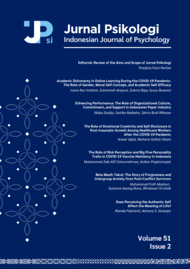Padjadjaran Interest Inventory:Evaluation of Psychometric Properties
Whisnu Yudiana(1*), Ilham Phalosa Reswara(2), Sudarmo Wiyono(3), R Urip Purwono(4)
(1) Departemen Psikologi Umum dan Eksperimen, Fakultas Psikologi, Universitas Padjadjaran
(2) Departemen Psikologi Pendidikan, Fakultas Psikologi, Universitas Padjadjaran
(3) Departemen Psikologi Pendidikan, Fakultas Psikologi, Universitas Padjadjaran
(4) Departemen Psikologi Klinis, Fakultas Psikologi, Universitas Padjadjaran
(*) Corresponding Author
Abstract
Keywords
Full Text:
PDFReferences
Betz, N. E., Harmon, L. W., & Borgen, F. H. (1996). The relationships of self-efficacy for the Holland themes to gender, occupational group membership, and vocational interests. Journal of Counseling Psychology, 43(1), 90.
Bloye, J. E. (2007). Vocational interest and other non-cognitive factor as predictors of academic performance in high school. Thesis: University of Johannesburg
Elena, M. A. (2014). The role of gender in the formation of vocational interests and career orientation in adolescence. Procedia - Social and Behavioral Sciences, 127, 240–244. doi: 10.1016/j.sbspro.2014.03.248
Etzel, J. M., Nagy, G., & Tracey, T. J. G. (2016). The Spherical Model of Vocational Interests in Germany. Journal of Career Assessment, 24(4), 701–717. doi: 10.1177/1069072715616122
Field, A. (2009). Discovering statistics using SPSS. London: Sage publications.
Hidi, S. (1990). Interest and its contribution as a mental resource for learning. Review of Educational Research, 60(4), 549–571.
Hidi, S., & Renninger, K. A. (2006). The four-phase model of interest development. Educational Psychologist, 41(2), 111–127.
Holland, J. L. (1973). Making vocational choices: A theory of careers. New Jersey: Prentice Hall.
Holland, J. L. (1985). Making vocational choices: A theory of personality and work environments (2nd ed.). New Jersey: Prentice Hall.
Holland, J. L. (1997). Making vocational choices: A theory of vocational personalities and work environments (3rd ed.). Odessa: Psychological Assessment Resources.
Hooper, D., Coughan, J., & Mullen, M. R. (2008). Structural equation modelling: Guidelines for determining model fit. Journal of Business and Research Methods, 6(1), 53–60.
Jansen, M., Lüdtke, O., & Schroeders, U. (2016). Evidence for a positive relation between interest and achievement: Examining between-person and within-person variation in five domains. Contemporary Educational Psychology, 46, 116–127. doi: 10.1016/ j.cedpsych.2016.05.004
Kaplan, R. M., & Sacuzzo, D. M. (2005). Psychological testing: Principles, applications, and issues. USA: Thomson & Wardsworth.
Kelly, R. K. (2002). Concurrent validity of the kuder career search activity preference scales and career clusters. Journal of Career Assessment, 10(1), 127–144.
Kuder, G. F. (1948). Kuder preference record-personal. Oxford: Science Research Associates.
Kuhn, T. (1962). The structure of scientific revolutions. University of Chicago Press.
Lawson, K. M., Lee, B., Crouter, A. C., & Mchale, S. M. (2018). Correlates of gendered vocational development from middle childhood to young adulthood. Journal of Vocational Behavior, 107(April), 209–221. doi: 10.1016/j.jvb.2018.05.002
Li, X., & Yang, X. (2016). Effects of learning styles and interest on concentration and achievement of students in mobile learning. Journal of Educational Computing Research, 54(7), 922–945. doi: 10.1177/0735633116639953
Long, L., Adams, R. S., & Tracey, T. J. G. (2005). Generalizability of interest structure to China: Application of the Personal Globe Inventory. Journal of Vocational Behavior, 66(1), 66–80. doi: 10.1016/j.jvb.2003.12.004
Maree, J. G., & Taylor, N. (2016). Development of the maree career matrix: A new interest inventory. South African Journal of Psychology, 46(4), 462–476. doi: 10.1177/0081246316641558
McDonald, R. P., & Ho, M.-H. R. (2002). Principles and practice in reporting structural equation analyses. Psychological Methods, 7(1), 64–82.
Miller, K. M. (1958). Manual for the Rothwell interest blank (Miller revision). Melbourne: Australian Council for Educational Research.
Revelle, W. (2017). An overview of the psych package. R package version 1.5.8. Evanston. Retrieved fromhttp://personality-project.org/r/overview.pdf
Rosseel, Y. (2012). lavaan : an R Package for Structural Equation Modeling. Journal of Statistical Software, 48(2), 1–21. doi: 10.18637/jss.v048.i02
Rothwell, J. W. (1947). A ranking method of assessing vocational interest. Melbourne: University of Melbourne.
Sharf, R. S. (2006). Applying career development theory to counseling. Belmont, CA Thomson: Nelson Education.
Sireci, S. G., & Sukin, T. (2013). Test validity. In K. F. Geisinger (Ed.), APA handbook of testing and assessment in psychology (pp. 85–100). Washington DC: American Psychological Association.
Sodano, S. M., & Tracey, T. J. G. (2008). Prestige in interest activity assessment. Journal of Vocational Behavior, 73(2), 310–317. doi: 10.1016/j.jvb.2008.07.002
Super, D. E. (1990). A life-span, life-space approach to career development. Dalam: Brown & L. Brooks (Eds.), Career choice and development: Applying contemporary theories to practice (2nd ed., pp. 197–261). San Fransisco: Josey-Bass.
Suwartono, C. (2016). Alat tes psikologi konteks indonesia: Tantangan psikologi di era MEA. Jurnal Psikologi Ulayat, 3(1), 6. doi: 10.24854/jpu12016-51
Šverko, I. (2008). Spherical model of interests in Croatia. Journal of Vocational Behavior, 72(1), 14–24. doi: 10.1016/j.jvb.2007.10.001
Tracey, T. J. G. (2002). Personal globe inventory: Measurement of the spherical model of interests and competence beliefs. Journal of Vocational Behavior, 60(1), 113–172. doi: 10.1006/jvbe.2001.1817
Tracey, T. J. G. (2010). Development of an abbreviated Personal Globe Inventory using item response theory: The PGI-Short. Journal of Vocational Behavior, 76(1), 1–15. doi: 10.1016/ j.jvb.2009.06.007
Tracey, T. J. G., & Rounds, J. (1997). Circular structure of vocational interests. Washington DC: American Psychological Association.
Tracey, T. J. G., & Rounds, J. B. (1992). Evaluating the RIASEC circumplex using high-point codes. Journal of Vocational Behavior1, 41, 295–311.
Volodina, A., & Nagy, G. (2016). Vocational choices in adolescence : The role of gender, school achievement, self-concepts, and vocational interests. Journal of Vocational Behavior, 95–96, 58–73. doi: 10.1016/j.jvb.2016.07.005
Yudiana, W. (2011). Perancangan dan evaluasi instrumen pengukuran minat untuk siswa Sekolah Menengah Atas Negeri di kota Bandung. Manuskrip tidak dipublikasikan. Universitas Padjadjaran.
Yudiana, W., Purwono, U., & Wiyono, S. (2011). Technical manual padjadjaran interest iventory. Bandung. Retrieved from https://www.researchgate.net/ publication/326292604_Technical_Manual_Padjadjaran_Interest_Inventory
Article Metrics
Refbacks
- There are currently no refbacks.
Copyright (c) 2019 Jurnal Psikologi

This work is licensed under a Creative Commons Attribution-ShareAlike 4.0 International License.
Recent Issues
 |  |  |  | ||||
| Vol 51 Issue 2 (2024) Page 120-230 | Vol 51 Issue 1 (2024) Page 1-119 | Vol 50 Issue 3 (2023) Page 219-332 | Vol 50 Issue 2 (2023) Page 125-218 |
| Published by Faculty of Psychology, Universitas Gadjah Mada, Indonesia Building D-6th, Floor No. D-606. Jl. Sosio Humaniora No. 1, Bulaksumur Yogyakarta, 55281 Email: jurnalpsikologi@ugm.ac.id Phone/whatsApp: +6281125210175 |











